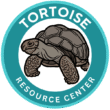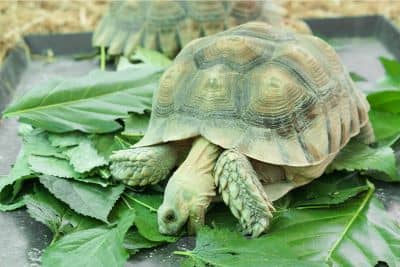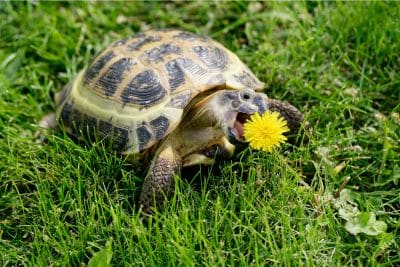Getting the Russian tortoise diet right is absolutely critical for keeping these popular pets healthy long-term. In their natural habitat, Russian tortoises are opportunistic feeders battling against rocky terrain and harsh, arid landscapes. This feast-or-famine existence with constant foraging means that in captivity, their Russian tortoise diet and enrichment activities must be carefully monitored to prevent serious health problems.
Here’s what makes the Russian tortoise diet so important to master: an easy captive life makes them prone to overeating and subsequent obesity. These tortoises evolved to walk miles daily searching for sparse vegetation in Central Asian deserts. When you put that same tortoise in an enclosure with unlimited food available, their natural survival instincts backfire. They’ll overeat because in the wild, they never knew when the next meal was coming. This leads to rapid growth, shell deformities, organ damage, and shortened lifespans.
The problem is that most Russian tortoise diet advice is either too vague (“feed them vegetables”) or doesn’t account for the massive difference between their natural food sources and what’s available in captivity. Wild Russian tortoises eat tough, fibrous plants with minimal nutritional density. Captive Russian tortoise diet plans often include nutrient-rich grocery vegetables that cause problems when fed in the same quantities they’d eat wild grasses. Getting the Russian tortoise diet wrong doesn’t just mean a chubby tortoise—it means metabolic bone disease, kidney failure, and liver damage.
This guide will walk you through everything about proper Russian tortoise diet requirements, from understanding their natural feeding behaviors to creating appropriate captive diets, knowing which foods are safe versus dangerous, and establishing feeding routines that keep your tortoise healthy for 50+ years.
- Understanding Natural Russian Tortoise Diet and Behavior
- Core Principles of Proper Russian Tortoise Diet
- Complete A-Z Russian Tortoise Diet Food List
- How and When to Feed Your Russian Tortoise
- Foods That Are Dangerous for Russian Tortoise Diet
- Essential Vitamins and Minerals for Russian Tortoise Diet
- Diet-Related Health Problems in Russian Tortoises
- Creating a Sustainable Russian Tortoise Diet Plan
- Ready to Perfect Your Russian Tortoise Diet?
- Citations
Understanding Natural Russian Tortoise Diet and Behavior
The native range of Russian tortoises (also known as Horsfield tortoises) primarily spans the arid regions of Central Asia, across countries like Russia, Iran, Afghanistan, Pakistan, and parts of Kazakhstan. Understanding their natural Russian tortoise diet begins with understanding this harsh environment that shaped their nutritional needs over millions of years.
These tortoises live naturally in environments with desert-like conditions and extreme temperature variations. Summers often exceed 100°F, while winters can drop below freezing with long, cold periods. Russian tortoises are adapted to survive these fluctuations by burrowing deep into the ground to find cool retreats during heat and insulation from cold at night. They also spend up to 5 months yearly hibernating.
The terrain in their native range is rocky and sandy with vegetation that’s generally low-growing and sparse. The natural Russian tortoise diet consists of wild grasses, weeds, and leafy plants that are tough and fibrous—nothing like the tender vegetables from grocery stores. Food availability varies seasonally, with more abundance in spring and early summer, creating their feast-or-famine survival pattern.
Seasonal behavior affecting diet: In the wild, Russian tortoises experience significant seasonal variations that impact feeding. In spring when vegetation is abundant, they’re highly active and eat more to build up reserves for harsher seasons. During extreme temperatures, they spend considerable time in burrows, which influences eating patterns. In summer they forage in early morning or late afternoon when temperatures are cooler, avoiding midday heat. In winter, they hibernate in burrows to conserve energy when food supplies are scarce.
Territorial and solitary nature: Russian tortoises tend to be territorial and prefer solitude or minimal interaction with other tortoises. In the wild, their foraging areas are quite expansive, and they typically avoid confrontation by spreading out over large territories. This means each tortoise walks substantial distances daily while foraging—exercise that captive tortoises often miss, making proper Russian tortoise diet portions even more critical.
Core Principles of Proper Russian Tortoise Diet
Wild Russian tortoises are strictly herbivores with diets mainly consisting of tough, fibrous plants, weeds, and grasses that are high in fiber and low in everything else—low protein, low fat, low moisture, and relatively low in easily digestible nutrients. This is the foundation you must replicate in captive Russian tortoise diet plans.
The 90/10 rule for Russian tortoise diet: When feeding captive Russian tortoises, aim for approximately 90% grasses, weeds, hay, and leafy greens with the remaining 10% made up of appropriate flowers and small amounts of vegetables. This ratio mimics what they’d naturally encounter while preventing the overfeeding that occurs when vegetables make up too much of the Russian tortoise diet.
Why fiber matters so much: Russian tortoises need rough, fibrous material to maintain proper gut motility and support the specialized digestive bacteria that break down tough plant material. Without adequate fiber, they develop impactions, digestive slowdowns, and bacterial imbalances. This is why a Russian tortoise diet based primarily on soft vegetables fails—these foods lack the fiber content Russian tortoises require.
Protein dangers: The natural Russian tortoise diet is extremely low in protein. Their kidneys simply cannot handle the protein levels present in many vegetables, legumes, or—heaven forbid—any animal products. Excess protein causes uric acid buildup leading to kidney stones, gout affecting joints, and potentially fatal organ damage. This makes protein management one of the most critical aspects of proper Russian tortoise diet planning.For growing Russian tortoises, ensuring proper nutrition ratios without overfeeding is particularly challenging. Our Baby Sulcata Superfood Powder works excellently for young Russian tortoises as well, providing balanced nutrition specifically formulated for herbivorous desert-adapted species during critical growth periods without the risks of inappropriate protein levels or rapid growth.
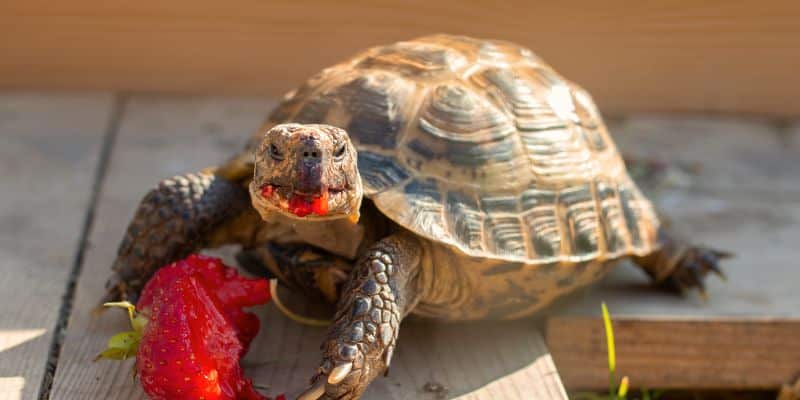
Complete A-Z Russian Tortoise Diet Food List
In the list below, I’ve provided suitable foods for Russian tortoise diet planning organized by category with nutritional information and appropriate feeding frequency.
Primary Foods (Feed Regularly):
Grasses and Hays: Timothy grass and hay should be the absolute foundation of any Russian tortoise diet—high in fiber, low in protein, excellent for digestion. Offer daily and unlimited amounts. Orchard grass and hay are soft, palatable, and high in fiber—excellent for regular feeding. Bermuda grass and hay are high in fiber and aid digestion—feed regularly. Kentucky Bluegrass is nutritious and easy to digest—feed regularly.
Leafy Greens: Dandelion (flowers and leaves both) is highly nutritious and should be a staple in Russian tortoise diet—feed regularly. Collard greens are high in calcium and fiber—feed regularly. Endive is rich in vitamins and minerals—feed regularly. Escarole has good vitamin and mineral content—feed regularly. Turnip greens are high in calcium and vitamins—feed regularly. Radicchio is high in vitamins—feed regularly. Mulberry leaves are rich in nutrients—feed regularly.
Flowers: Hibiscus (flowers and leaves both) are safe and nutritious—feed regularly. Rose petals (and leaves) are safe but ensure they’re pesticide-free—feed regularly.
Moderate Use Foods (Feed Occasionally):
Hays and Grasses: Alfalfa hay has high calcium and protein content—offer only occasionally as too much protein stresses kidneys. Fescue is highly nutritious but also has high protein—occasional only. Rye grass is safe but contains high protein—occasional feeding only. Wheat grass is high in fiber and vitamins—feed occasionally for variety.
Vegetables: Bell peppers are high in vitamins A and C—feed in moderation. Carrots are rich in beta-carotene but have high sugar content—occasional feeding only. Pumpkin is high in fiber and vitamins—feed occasionally. Squash is nutritious and safe—feed in moderation. Zucchini is low in calories—feed in moderation. Bok Choy contains goitrogens—occasional only.
Leafy Greens: Kale is packed with vitamins but has high goitrogen content—feed in moderation only. Mustard greens are nutritious but have high oxalate content—occasional feeding. Romaine lettuce has high water content and fiber—feed in moderation as it’s not very nutritious.
Flowers and Leaves: Grape leaves are nutritious and safe but contain oxalates—occasional feeding. Marigold flowers are edible—occasional. Nasturtium flowers and leaves are both safe—occasional. Pansy flowers are edible—in moderation. Petunia flowers are safe—in moderation. Raspberry leaves are edible and safe—occasional. Strawberry leaves are safe and nutritious—occasional.
Rare Treats Only (Monthly or Less):
Fruits: The natural Russian tortoise diet contains virtually no fruit. While they love fruit, their digestive systems cannot handle sugar well. Apple (small pieces without seeds), blackberries, blueberries, fig, mango, melon, papaya, pear, and strawberries should all be offered rarely if at all—perhaps monthly at most. Expect digestive upset and loose stools after fruit feeding.
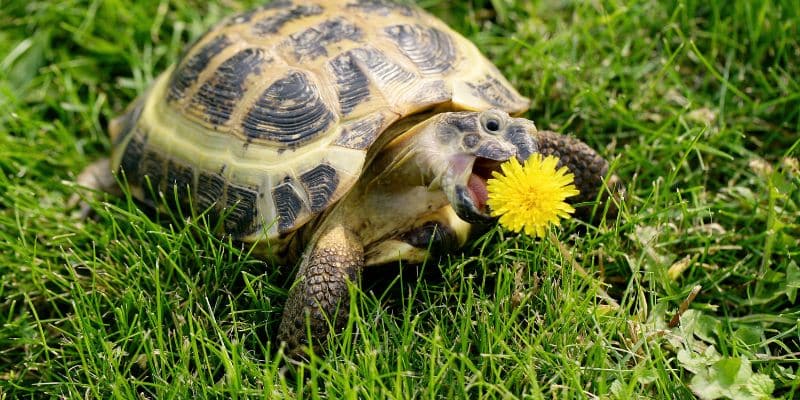
How and When to Feed Your Russian Tortoise
Variety is key when it comes to a healthy Russian tortoise diet, but so is consistency in scheduling and portion control. Stick to a regular feeding schedule and try to provide a selection of 3-5 different items from the approved food list at every mealtime.
My feeding routine for adults: I feed adult Russian tortoises every other day, which works well for their metabolism and prevents obesity. When preparing Russian tortoise diet portions, I mix approximately 90% leaves, weeds, hay, and grass with the remaining 10% made up of a few flowers and small amounts of vegetables.
Any larger or tougher pieces get chopped up or shredded for easier consumption. I always remove any wilted, moldy, or spoiled foods immediately as these can cause digestive issues, infections, and even parasites.
I put some of the food mix on a feeding plate and scatter the rest in cooler areas of the enclosure to encourage foraging and exercise. Leaving everything on the feeding plate made my tortoises lazy and less inclined to move about—the scattered feeding mimics natural foraging behavior and keeps them active.
Feeding hatchlings and juveniles: When I have hatchlings, I feed them daily with a chopped-up version of the same Russian tortoise diet mix I use for adults. I place the plate near them and set a timer for 30 minutes. Whatever hasn’t been eaten after that time gets removed to prevent spoilage and discourage overeating.
Food preparation and storage: I go foraging for weeds and leaves weekly. After washing, I place them in ziplock plastic bags in the bottom refrigerator compartment. This makes feeding times much easier and food stays fresh for 5-7 days.
I’m lucky to have space to grow vegetables and weeds in my backyard, which supplies my Russian tortoises through summer months. Out of season, I buy vegetables from grocery stores, give them thorough washes, and keep them refrigerated until needed. I buy hay wholesale from local suppliers and store it in dry areas until needed.
About fruit in Russian tortoise diet: I only offer fruit on very rare occasions—not because they don’t like it (they absolutely love it), but because it doesn’t agree with their digestive systems. I end up clearing extra soiled substrate for 24+ hours after fruit feeding due to digestive upset. The sugar content simply isn’t appropriate for Russian tortoise diet requirements.
Foods That Are Dangerous for Russian Tortoise Diet
Now that you know appropriate Russian tortoise diet components, let’s look at foods you should NEVER feed your Russian tortoise.
Meat or Dairy: Russian tortoises require very low-protein diets. Though they may happen across occasional carrion in the wild, meat and dairy contain far too much protein for them to safely eat. These foods cause immediate digestive upset and long-term kidney damage. Never include any animal products in Russian tortoise diet plans.
High-Protein Vegetation: Some vegetables, legumes, and hays contain dangerously high protein levels. Avoid beans, peas, and large amounts of fescue, rye, and alfalfa hay in Russian tortoise diet. These contain protein amounts that overwhelm their kidneys and cause uric acid buildup.
Too Much Fruit: Russian tortoises have digestive systems adapted to process high-fiber, low-sugar foods. Excess sugar in fruit causes digestive issues and obesity. Additionally, many fruits have disproportionate calcium-to-phosphorus ratios. Too much phosphorus affects the tortoise’s ability to absorb calcium, potentially leading to metabolic bone disease. Fruit should be extremely limited or eliminated from Russian tortoise diet entirely.
Grains: Grains such as wheat and barley contain relatively high protein amounts and should be avoided in Russian tortoise diet. While tortoises can eat grass from wheat or barley plants, the seeds and grain products themselves are inappropriate.
Vegetables Containing Oxalates: Although vegetables such as spinach, chard, cabbage, broccoli, and beetroot contain nutrients, they also contain high oxalate levels and should be avoided or offered very rarely in Russian tortoise diet. This compound binds with calcium, preventing proper absorption and potentially causing kidney disease.
Vegetables Containing Goitrogens: Vegetables from the brassica family should be fed in moderation or not at all in Russian tortoise diet. I avoid cabbage and cauliflower and only feed kale and broccoli on rare occasions. Most brassicas contain high goitrogen levels which can interfere with thyroid activity and possibly damage liver and kidneys.
Essential Vitamins and Minerals for Russian Tortoise Diet
Calcium is vitally important to overall tortoise health, and deficiency results in poor bone development, growth rate abnormalities, shell deformities, and even metabolic bone disease. Even with perfect Russian tortoise diet composition, supplementation is often necessary.
If you’re concerned your Russian tortoise isn’t getting adequate vitamins and minerals, or you’re seeing signs of poor growth rate, shell deformities, or even fractures, supplementing their Russian tortoise diet with a comprehensive vitamin and mineral formula is essential.
Our Vitamin and Mineral Topper provides balanced mineral support specifically formulated for herbivorous tortoises like Russians, ensuring complete nutrition even when fresh food variety is limited. This is particularly important during rapid growth periods when nutritional demands are highest and deficiencies develop quickly.
If in doubt about supplementation needs, book a check-up with your veterinarian to determine the best supplementation routine for your pet’s specific Russian tortoise diet requirements.
Are You Starving Your Tortoise?
Save 10% on premium tortoise food and supplements from Tortoise Resource Center on Amazon now using code BUYNOWGET10
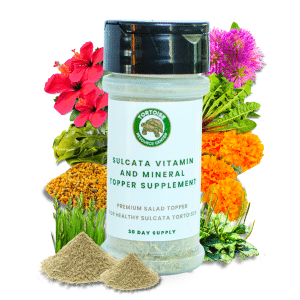
Sulcata Vitamin & Mineral Topper Supplement
30-Day Supply | 2 oz (56 g)
$24.99
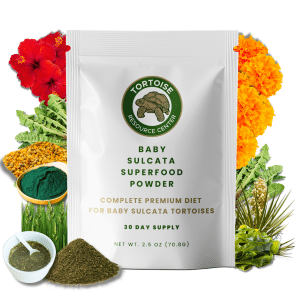
Baby Sulcata Tortoise Superfood Powder
30-Day Supply | 2.5 oz (70.8 g) Bag
$24.99
Diet-Related Health Problems in Russian Tortoises
Below are the most common Russian tortoise health issues directly attributable to poor Russian tortoise diet. If symptoms are spotted early, most can be treated with dietary tweaks and appropriate supplementation. However, if problems persist or worsen, contact your veterinarian immediately.
Calcium Deficiency: Shell softening or deformity leading to metabolic bone disease. Caused by lack of UVB light, lack of calcium-rich foods in Russian tortoise diet, or excessive phosphorus. This is preventable with proper Russian tortoise diet planning including appropriate calcium supplementation.
Oxalate Buildup: Kidney stones, lethargy, loss of appetite, stress, and shell softening or deformities. Caused by feeding excessive amounts of high-oxalate foods in Russian tortoise diet, lack of variety, or calcium deficiency. Avoid spinach, chard, and similar vegetables.
Improper Growth: Rapid growth, obesity, and shell deformities including pyramiding. Caused by under or overfeeding, lack of calcium in Russian tortoise diet, excess protein, or dehydration. This is one of the most common problems from inappropriate Russian tortoise diet composition—particularly when vegetables make up too much of the diet.
Toxic Shock Syndrome: Digestive issues and diarrhea caused by gut bacteria imbalance from excessive sugar or acid in Russian tortoise diet, typically from fruit. This can be severe or fatal if not addressed. Fruit should be virtually eliminated from Russian tortoise diet to prevent this condition.
Uric Acid Buildup: Kidney or bladder stones, gout, joint pain, and heart conditions. Caused by excessive protein in Russian tortoise diet. This develops slowly but causes permanent organ damage. Keeping protein levels appropriate is non-negotiable for long-term health.
Creating a Sustainable Russian Tortoise Diet Plan
The Russian tortoise diet advice provided here is intended as a framework. Each tortoise is different in terms of preferences, overall nutrient needs, and food volume requirements. You’ll need to make adjustments based on your individual tortoise’s response.
Monitor body condition regularly: Weigh your Russian tortoise monthly and schedule veterinary check-ups every 6-12 months. If weight increases too rapidly or you see fat deposits around the neck and legs, reduce portions in your Russian tortoise diet plan. If growth seems stunted or the tortoise appears thin, increase food amounts or variety.
Adjust for activity levels: Tortoises with large outdoor enclosures requiring significant walking need more food than those in compact indoor setups. Active tortoises burn more calories foraging, while sedentary tortoises in small enclosures need smaller Russian tortoise diet portions to prevent obesity.
Seasonal considerations: Many Russian tortoises naturally eat less during cooler months and more during warmer seasons. This is normal and reflects their wild behavior. Don’t force-feed during low-appetite periods, but continue offering appropriate Russian tortoise diet options regularly.
Hydration matters: While Russian tortoises are adapted to arid conditions, they still need regular water access. Provide fresh water daily and offer weekly soaks for 15-20 minutes in shallow lukewarm water. Proper hydration prevents kidney problems and helps process the high-fiber Russian tortoise diet appropriately.
Ready to Perfect Your Russian Tortoise Diet?
Mastering Russian tortoise diet isn’t just about keeping your tortoise alive—it’s about providing the nutritional foundation for 50+ years of vibrant health. The Russian tortoise diet you provide determines whether your pet develops strong bones and proper shell formation or suffers from deformities and organ damage. It determines whether they live their full potential lifespan or succumb to preventable kidney failure or metabolic bone disease in their teens or twenties.
The good news is that proper Russian tortoise diet becomes straightforward once you understand the principles. Focus on grass and hay as the foundation. Add appropriate leafy greens and minimal vegetables. Avoid the temptation to feed them like omnivorous pets. Resist offering fruit despite how much they seem to enjoy it. Provide consistent, appropriate portions that account for their sedentary captive lifestyle compared to wild walking patterns.
Want comprehensive guidance on perfecting your Russian tortoise diet for every life stage and situation? Sign up for our free bonus pack and get instant access to detailed meal plans, seasonal feeding schedules, troubleshooting guides for picky eaters, complete food safety lists, and portion calculators. Plus you’ll receive growth tracking charts, health monitoring guides, and expert tips for preventing diet-related health problems in Russian tortoises.
Your Russian tortoise is counting on you to provide the nutrition they need to thrive for decades. With the right knowledge and consistent application of proper Russian tortoise diet principles, you can give them exactly that—a long, healthy life built on the foundation of appropriate nutrition every single day.
Citations
European Studbook Foundation – All about Vitamins and Minerals in Tortoises Merck Veterinary Manual – Metabolic and Endocrine Diseases of Reptiles
